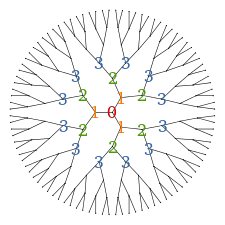Bethe lattice

A Bethe lattice, introduced by Hans Bethe in 1935, is an infinite connected cycle-free graph where each node is connected to z neighbours, where z is called the coordination number. It is a rooted tree, with all other nodes arranged in shells around the root node, also called the origin of the lattice. The number of nodes in the kth shell is given by
In some situations the definition is modified to specify that the root node has z − 1 neighbors.
Due to its distinctive topological structure, the statistical mechanics of lattice models on this graph are often exactly solvable. The solutions are related to the often used Bethe approximation for these systems.
Since this is a cycle free graph, every vertex connects from the caley tree to a new node, then the average connectivity of each particle c is given by
Relation to Cayley graphs
The Bethe lattice where each node is joined to 2n others is essentially the Cayley graph of a free group on n generators.
A presentation of a group G by n generators corresponds to a surjective map from the free group on n generators to the group G, and at the level of Cayley graphs to a map from the Bethe lattice (with distinguished root corresponding to the identity) to the Cayley graph. This can also be interpreted (in algebraic topology) as the universal cover of the Cayley graph, which is not in general simply connected.
The distinction between a Bethe lattice and a Cayley tree is that the former is infinite, while the latter is finite. A Bethe lattice is defined by its coordination number. It has no root, since every vertex is identical, with z neighbors. It also has no surface since it extends to infinity. On the other hand a Caley tree is also defined by the number of layers and it has a root and a highly non-negligible surface.[1]
Lattices in Lie groups
Bethe lattices also occur as the discrete group subgroups of certain hyperbolic Lie groups, such as the Fuchsian groups. As such, they are also lattices in the sense of a lattice in a Lie group.
See also
References
- ↑ Ostilli, M. (2012). "Cayley Trees and Bethe Lattices, a concise analysis for mathematicians and physicists". Physica A. 391: 3417. arXiv:1109.6725. Bibcode:2012PhyA..391.3417O. doi:10.1016/j.physa.2012.01.038.
- Bethe, H. A. (1935). "Statistical theory of superlattices". Proc. Roy. Soc. Lond. A. 150: 552–575. Bibcode:1935RSPSA.150..552B. doi:10.1098/rspa.1935.0122. Zbl 0012.04501.
- Baxter, Rodney J. (1982). Exactly solved models in statistical mechanics. Academic Press. ISBN 0-12-083182-1. Zbl 0538.60093.